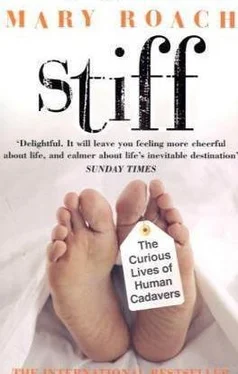I like the term “decedent.” It’s as though the man weren’t dead, but merely involved in some sort of protracted legal dispute. For evident reasons, mortuary science is awash with euphemisms. “Don’t say stiff, corpse, cadaver,” scolds The Principles and Practice of Embalming . “Say decedent, remains or Mr. Blank. Don’t say ‘keep.’ Say ‘maintain preservation.’ … “Wrinkles are ‘acquired facial markings.’ Decomposed brain that filters down through a damaged skull and bubbles out the nose is ‘frothy purge.’”
The last feature to be posed is the mouth, which will hang open if not held shut. Theo is narrating for Nicole, who is using a curved needle and heavy-duty string to suture the jaws together. “The goal is to reenter through the same hole and come in behind the teeth,” says Theo. “Now she’s coming out one of the nostrils, across the septum, and then she’s going to reenter the mouth. There are a variety of ways of closing the mouth,” he adds, and then he begins talking about something called a needle injector. I pose my own mouth to resemble the mouth of someone who is quietly horrified, and this works quite well to close Theo’s mouth.
The suturing proceeds in silence.
Theo and Nicole step back and regard their work. Mack nods. Mr. Blank is ready for embalming.
Modern embalming makes use of the circulatory system to deliver a liquid preservative to the body’s cells to halt autolysis and put decay on hold. Just as blood in the vessels and capillaries once delivered oxygen and nutrients to the cells, now those same vessels, emptied of blood, are delivering embalming fluid. The first people known to attempt arterial embalming [10] But by no means the first to attempt to keep bodies from rotting. Outtakes of the early days of corporeal preservation included a seventeenth-century Italian physician named Girolamo Segato, who devised a way of turning bodies into stone, and a London M.D. named Thomas Marshall, who, in 1839, published a paper describing an embalming technique that entailed generously puncturing the surface of the body with scissors and then brushing the body with vinegar, much the way the Adolph’s company would have housewives prick steaks to get the meat tenderizer way down in.
were a trio of Dutch biologists and anatomists named Swammerdam, Ruysch, and Blanchard, who lived in the late 1600s. The early anatomists were dealing with a chronic shortage of bodies for dissection, and consequently were motivated to come up with ways to preserve the ones they managed to obtain. Blanchard’s textbook was the first to cover arterial embalming. He describes opening up an artery, flushing the blood out with water, and pumping in alcohol. I’ve been to frat parties like that.
Arterial embalming didn’t begin to catch on in earnest until the American Civil War. Up until this point, dead U.S. soldiers were buried more or less where they fell. Their families had to send a written request for disinterment and ship a coffin capable of being hermetically sealed to the nearest quartermaster office, whereupon the quartermaster officer would assign a team of men to dig up the remains and deliver them to the family. Often the coffins that the families sent were not hermetically sealed—who knew what “hermetically” meant? Who knows now?—and they soon began to stink and leak. At the urgent pleadings of the beleaguered delivery brigades, the army set about embalming its dead, some 35,000 in all.
One fine day in 1861, a twenty-four-year-old colonel named Elmer Ellsworth was shot and killed as he seized a Confederate flag from atop a hotel, his rank and courage a testimony to the motivating powers of a humiliating first name. The colonel was given a hero’s send-off and a first-class embalming at the hands of one Thomas Holmes, the Father of Embalming. [11] Does everything have a father? Apparently so. A web search on “the father of” turned up fathers for vasectomy reversal, hillbilly jazz, lichenology, snowmobiling, modern librarianship, Japanese whiskey, hypnosis, Pakistan, natural hair care products, the lobotomy, women’s boxing, Modern Option Pricing Theory, the swamp buggy, Pennsylvania ornithology, Wisconsin bluegrass, tornado research, Fen-Phen, modern dairying, Canada’s permissive society, black power, and the yellow schoolbus.
The public filed past Elmer in his casket, looking every bit the soldier and nothing at all the decomposing body. Embalming received another boost four years later, when Abe Lincoln’s embalmed body traveled from Washington to his hometown in Illinois. The train ride amounted to a promotional tour for funerary embalming, for wherever the train stopped, people came to view him, and more than a few must have noted that he looked a whole lot better in his casket than Grandmama had looked in hers. Word spread and the practice grew, like a chicken heart, and soon the whole nation was sending their decedents in to be posed and preserved.
After the war, Holmes set up a business selling his patented embalming fluid, Innominata, to embalmers, but otherwise began to distance himself from the mortuary trade. He opened a drugstore, manufactured root beer, and invested in a health spa, and between the three of them managed to squander his considerable savings. He never married and fathered no children (other than Embalming), but it wouldn’t be accurate to say he lived alone. According to Christine Quigley, author of The Corpse: A History , he shared his Brooklyn house with samples of his war-era handiwork: Embalmed bodies were stored in the closets, and heads sat on tables in the living room. Not all that surprisingly, Holmes began to go insane, spending his final years in and out of institutions. At seventy, he was placing ads in mortuary trade journals for a rubber-coated canvas body removal bag that could, he suggested, double as a sleeping bag . Shortly before he died, Holmes is said to have requested that he not be embalmed, though whether this was a function of sanity or insanity was never made clear.
Theo is feeling around on Mr. Blank’s neck. “We’re in search of the carotid artery,” he announces. He cuts a short lengthwise slit in the man’s neck. Because no blood flows, it is easy to watch, easy to think of the action as simply something a man does on his job, like cutting roofing material or slicing foam core, rather than what it would more normally be: murder. Now the neck has a secret pocket, and Theo slips his finger into it. After some probing, he finds and raises the artery, which is then severed with a blade. The loose end is pink and rubbery and looks very much like what you blow into to inflate a whoopee cushion.
A cannula is inserted into the artery and connected by a length of tubing to the canister of embalming fluid. Mack starts the pump.
Here is where it all begins to make sense. Within minutes, the man’s face looks rejuvenated. The embalming fluid has rehydrated his tissues, filling out his sunken cheeks, his lined skin. His skin is pink now (the embalming fluid contains red coloring), no longer slack and papery. He looks healthy and surprisingly alive. This is why you don’t just stick bodies in the refrigerator before an open-casket funeral.
Mack is telling me about a ninety-seven-year-old woman who looked sixty after her embalming. “We had to paint in wrinkles, or the family wouldn’t recognize her.”
As hale and youthful as our Mr. Blank looks this morning, he will still eventually decompose. Mortuary embalming is designed to keep a cadaver looking fresh and uncadaverous for the funeral service, but not much longer. (Anatomy departments amp up the process by using greater amounts and higher concentrations of formalin; these corpses may remain intact for years, though they take on a kind of pickled horror-movie appearance.) “As soon as the water table comes up, and the coffin gets wet,” Mack allows, “you’re going to have the same kind of decomposition you would have had if you hadn’t done embalming.” Water reverses the chemical reactions of embalming, he says.
Читать дальше












